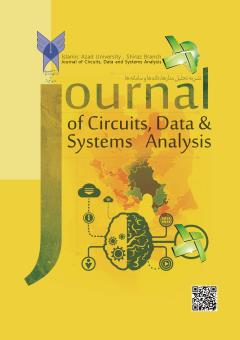Optimal Classification of Brain Tumors in MRI Images Using Deep Learning Techniques
Subject Areas : Biomedical Engineering
Zohreh Arabi
1
![]() ,
Omid Mahdiyar
2
,
Omid Mahdiyar
2
![]() ,
Mehdi Taghizadeh
3
*
,
Mehdi Taghizadeh
3
*
![]()
1 - Department of Electrical Engineering, Kazerun Branch, Islamic Azad University, Kazerun, Iran
2 - Department of Electrical Engineering, Kazerun Branch, Islamic Azad University, Kazerun, Iran
3 - Department of Electrical Engineering, Kazerun Branch, Islamic Azad University, Kazerun, Iran
Keywords: Medical Imaging, Brain tumors, Deep learning, MRI image, glioma, meningioma, pituitary,
Abstract :
Medical and biological imaging technologies provide valuable image information of the structure and function of an organ from the level of molecules to the whole body. The brain is the most complex organ in the body and is attracting increasing research attention with the rapid development of medical and biological imaging technologies. One of the most common brain diseases is the creation of abnormal tissue in brain cells, which leads to the formation of brain tumors. Since brain tumors are associated with a significant risk of death and the accurate and rapid prediction of this disease has a direct impact on the treatment process, therefore, in this research, a large number of brain tumor MRI imaging data was used to identify brain cancers and find a method. Deep learning techniques were used. Several deep learning models were used for automatic diagnosis, and the classification of three types of brain tumors, consisting of glioma, meningioma, and pituitary, was also done with these algorithms. Based on the results of the conducted tests, the best accuracy of the results obtained in this research was 96%, which was obtained by considering the ratio of 60% for training data and 40% for test data.
[1] A. E. Minarno, M. H. C. Mandiri, Y. Munarko, and H. Hariyady, "Convolutional Neural Network with Hyperparameter Tuning for Brain Tumor Classification," Kinetik: Game Technology, Information System, Computer Network, Computing, Electronics, and Control, vol.6,no.2,pp.127–132,May2021, doi: 10.22219/KINETIK.V6I2.1219.
[2] D. H. Gutmann and H. Kettenmann, "Microglia/Brain Macrophages as Central Drivers of Brain Tumor Pathobiology," Neuron, vol. 104, no. 3, pp. 442–449, Nov. 2019, doi: 10.1016/J.NEURON.2019.08.028.
[3] T. Nejo, A. Mende, and H. Okada, "The current state of immunotherapy for primary and secondary brain tumors: similarities and differences," Japanese Journal of Clinical Oncology, vol. 50, no.11, pp. 1231–1245, Oct. 2020, doi: 10.1093/JJCO/HYAA164.
[4] W. Tomaszewski, L. Sanchez-Perez, T. F. Gajewski, and J. H. Sampson, "Brain tumor microenvironment and host state: Implications for immunotherapy," Clinical Cancer Research, vol. 25, no. 14, pp. 4202–4210, Jul. 2019, doi: 10.1158/1078-0432.CCR-18-1627.
[5] C. K. Kuhl, "Abbreviated Magnetic Resonance Imaging (MRI) for Breast Cancer Screening: Rationale, Concept, and Transfer to Clinical Practice," Annu Rev Med, vol. 70, pp. 501–519, Jan. 2019, doi: 10,1146/ANNUREV-MED-121417-100403.
[6] H. H. Sultan, N. M. Salem, and W. Al-Atabany, "Multi-Classification of Brain Tumor Images Using Deep Neural Network," IEEE Access, vol. 7, pp. 69215–69225, 2019, doi: 10.1109/ACCESS.2019.2919122.
[7] A. Gumaei, M. M. Hassan, M. R. Hassan, A. Alelaiwi, and G. Fortino, "A Hybrid Feature Extraction Method with Regularized Extreme Learning Machine for Brain Tumor Classification," IEEE Access, vol. 7, pp. 36266–36273, 2019, doi: 10.1109/ACCESS.2019.2904145.
[8] S. Deepak and P. M. Ameer, "Brain tumor classification using deep CNN features via transfer learning," Computers in Biology and Medicine, vol. 111, p. 103345, Aug. 2019, doi:10, 1016/J.COMPBIOMED.2019.103345.
[9] “Brain_tumor_Dataset” https://figshare.com/articles/dataset/brain_tumor_dataset/1512427(accessed Jun. 09, 2022).
[10] Z. N. K. Swati et al., "Brain tumor classification for MR images using transfer learning and fine-tuning," Comput Med Imaging Graph, vol 75, pp.34–46, Jul.2019, doi: 10.11016/J.COMPMEDIMAG.2019.05.001.
[11] N. Noreen, S. Palaniappan, A. Qayyum, I. Ahmad, M. Imran, and M. Shoaib, "A Deep Learning Model Based on Concatenation Approach for the Diagnosis of Brain Tumor," IEEE Access, vol. 8, pp. 55135– 55144, 2020, doi: 10.1109/ACCESS.2020.2978629.
[12] H. Hairani, K. E. Saputro, and S. Fadli, “K-means-SMOTE untuk menangani ketidakseimbangan kelas dalam klasifikasi penyakit diabetes dengan C4.5, SVM, dan naive Bayes,” Jurnal Teknologi dan Sistem Komputer, vol. 8, no. 2, pp. 89–93, Apr. 2020, doi:10,14710/JTSISKOM.8.2.2020.89-93.
[13] S. H. Wang and Y. D. Zhang, "DenseNet-201-Based Deep Neural Network with Composite Learning Factor and Precomputation for Multiple Sclerosis Classification," ACM Transactions on Multimedia Computing, Communications, and Applications (TOMM), vol. 16, no. 2s, Jun. 2020, doi: 10.1145/3341095.
[14] S. Deepak and P. M. Ameer, "Brain tumor classification using deep CNN features via transfer learning," Computers in Biology and Medicine, vol. 111, p. 103345, Aug. 2019, doi: 10.1016/J.COMPBIOMED.2019.103345.
[15] N. Noreen, S. Palaniappan, A. Qayyum, I. Ahmad, M. Imran, and M. Shoaib, "A Deep Learning Model Based on Concatenation Approach for the Diagnosis of Brain Tumor," IEEE Access, vol. 8, pp. 55135–55144, 2020, doi: 10.1109/ACCESS.2020.2978629.
[16] M. C. Xenya and Z. Wang, "Brain Tumour Detection and Classification using Multi-Level Ensemble Transfer Learning in MRI Dataset," icABCD 2021 - 4th International Conference on Artificial Intelligence, Big Data, Computing and Data Communication Systems, Proceedings, Aug. 2021, doi: 10.1109/ICABCD51485.2021.9519361.
[17] N. M. Dipu, S. A. Shohan, and K. M. A. Salam, "Deep Learning Based Brain Tumor Detection and Classification," 2021 International Conference on Intelligent Technologies, CONIT 2021, Jun. 2021, doi:10,1109/CONIT51480.2021.9498384.
[18] R. M. Prakash and R. S. S. Kumari, "Classification of MR brain images for detection of tumor with transfer learning from pre-trained CNN models," 2019 International Conference on Wireless Communications, Signal Processing and Networking, WiSPNET 2019, pp.508–511, Mar. 2019, doi: 10,1109/WISPNET45539.2019.9032811.
[19] Y. Guo, S. Liu, Z. Li, X. Shang, "BCDForest: a boosting cascade deep forest model towards the classification of cancer subtypes based on gene expression data." BMC Bioinform 19(5),118, 2018.

